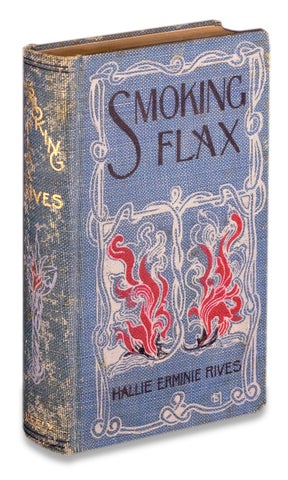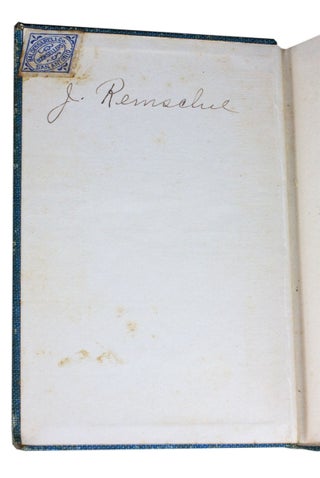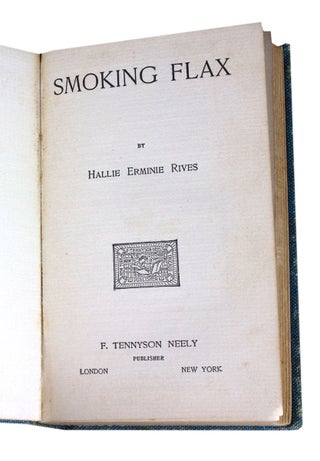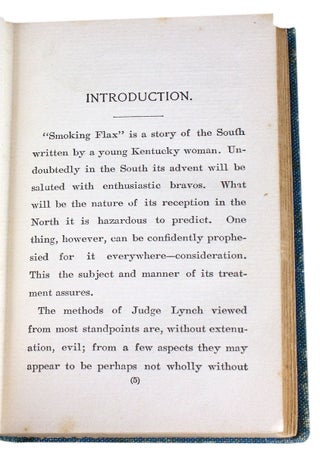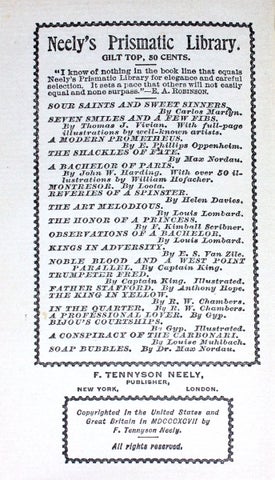Smoking Flax.
Controversial novel by a Southern woman concerning slavery, accusations of the rape and murder of a white woman by a Black American, and lynching
Rare first edition. Controversial novel in favor of lynching, written by Southern woman author, Hallie Erminie Rives (1874–1956). The book concerns issues of slavery and accusations of rape and murder of a white woman by a Black man.
From the introduction:
“Smoking Flax” is a story of the South written by a young Kentucky woman. Undoubtedly in the South its advent will be saluted with enthusiastic bravos. What will be the nature of its reception in the North it is hazardous to predict. One thing, however, can be confidently prophesied for it everywhere—consideration. This the subject and manner of its treatment assures. The methods of Judge Lynch viewed from most standpoints are, without extenuation, evil; from a few aspects they may appear to be perhaps not wholly without justification. Miss Rives, through the medium of romance, presents the question as seen from many sides, and then leaves to the reader the responsibility of determining “what is truth,” though where her own sympathies lie she does not leave much in doubt.
“Judge Lynch” here is a reference to Virginia jurist Charles Lynch (1736–1796), noted for his support of summary trials and extra-judicial proceedings during the American Revolution. By the time of the publication of Rives’ Smoking Flax, however, lynching was firmly associated with mob violence and hangings.
Rives describes the vicious murder of a beautiful white woman whose throat was allegedly slashed with a razor by a Black man. In addition to using such words as “animal-like,” “savage,” and “sinister” to describe the accused, Rives writes: “His speech was not that of a common negro, but of a lettered man, and seemed strangely at variance with his bearded, scowling face.” (p172) In the novel, it happens that the accused holds a respectable job as a school teacher.
A posse is quickly formed to capture the alleged perpetrator. After this Black American teacher is in custody, the sheriff tries to protect him from an angry mob:
As [the chief deputy] gazed about him, he slowly asked: “Did that d——d n[***]er die after all?” The sheriff had not time to tell him that the negro was safe, for the next minute there came a volley of yells and sounds of oaths with the dull thunder of rapidly advancing hoofbeats, and before either man could speak again, a party of armed riders reined up in front of the ford. ... The quivering negro, terrified by the idea that the pursuers were upon them, made an effort to rise. “My God! don’t let them take me! Don’t give me up!” There was something savage and frenzied in the accent that went with those words. He clutched at the sheriff’s knees, his eyes became wild and fixed and filled with terror. “We must have your prisoner,” someone shouted. “Will you surrender him?” “Not yet,” was the sheriff’s answer. “I deliver him only to the law.” “You’ll give him up!” cried a score of determined voices. “Never! Never!” “Then we will fire on him!” (pp182–184)
The trial was delayed until the next sitting of a grand jury and was further postponed because of the absence of a witness for the defense. When the trial finally came, the accused is convicted and sentenced to death.
Later, after receiving a last minute commuted sentence of life in prison from the governor of Kentucky, the prisoner is whisked away on the midnight train from the slumbering town. Suddenly, an “unkempt figure” leaps from the platform onto the departing train with a pistol and shoots the accused through the heart. In the end, vigilante “justice” is served: “By the time the train had drawn back to the station, the platform was deserted; only the shrouding mists of blue smoke remained.” (p232)
The publisher’s decorative trade cloth bookbinding, designed by Harry B. Matthews (active 1897–1907), depicts a burning fire. From the red flames, stylized “shrouding mists of blue smoke” emanate. Despite the author’s pro-lynching sentiments, this hazy mist seems aptly symbolic of the evil of justice by lynching.
Description: Smoking Flax.
London and New York: F. Tennyson Neely Publisher, (1897). 232, [8 (publisher’ adverts)]pp., top-edge gilt. First Edition. Small 8vo. Publisher’s decorative cloth trade bookbinding, signed “HBM” for Harry B. Matthews. Bookseller’s ticket from San Antonio, Texas. Spine with rubbing, per usual, boards with scattered foxing; very good.
[3729427]Not in Wright.
Price: $650.00

![[3729427] Smoking Flax. Hallie Erminie Rives, 1874–1956.](https://rareamericana.cdn.bibliopolis.com/pictures/3729427.jpg?width=768&height=1000&fit=bounds&auto=webp&v=1596657592)
